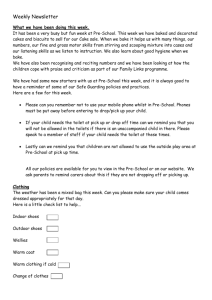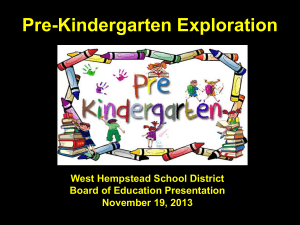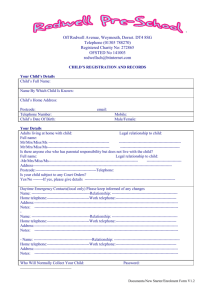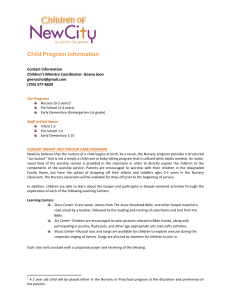Comments From SELB Pre-School Education Advisory Group (PEAG)
advertisement
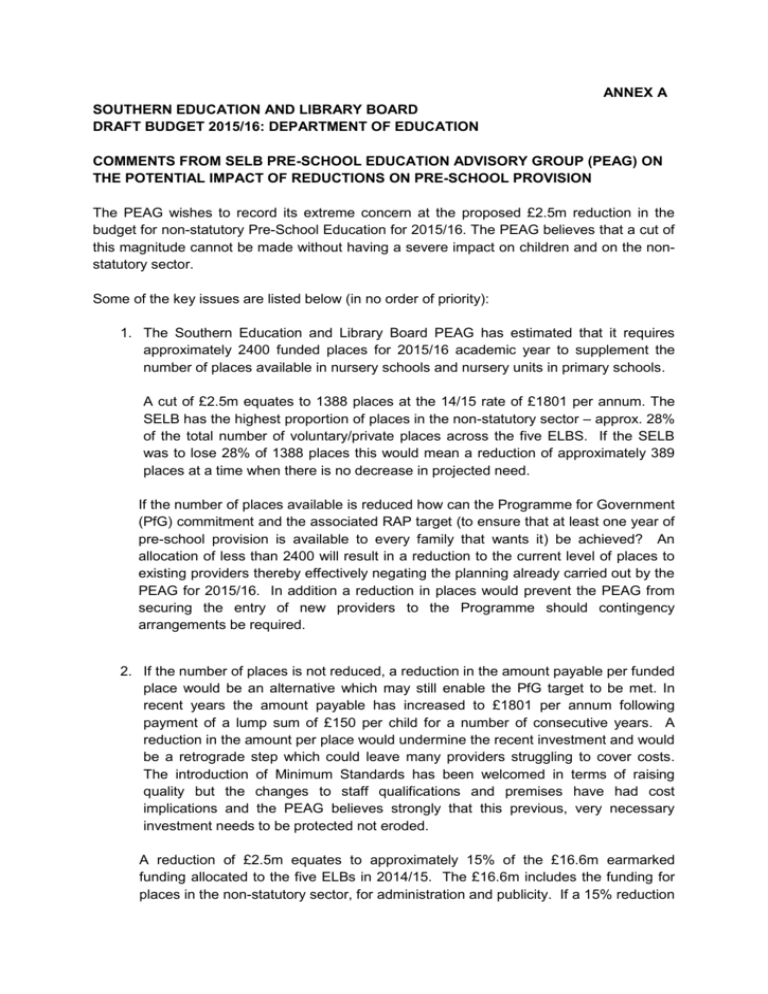
ANNEX A SOUTHERN EDUCATION AND LIBRARY BOARD DRAFT BUDGET 2015/16: DEPARTMENT OF EDUCATION COMMENTS FROM SELB PRE-SCHOOL EDUCATION ADVISORY GROUP (PEAG) ON THE POTENTIAL IMPACT OF REDUCTIONS ON PRE-SCHOOL PROVISION The PEAG wishes to record its extreme concern at the proposed £2.5m reduction in the budget for non-statutory Pre-School Education for 2015/16. The PEAG believes that a cut of this magnitude cannot be made without having a severe impact on children and on the nonstatutory sector. Some of the key issues are listed below (in no order of priority): 1. The Southern Education and Library Board PEAG has estimated that it requires approximately 2400 funded places for 2015/16 academic year to supplement the number of places available in nursery schools and nursery units in primary schools. A cut of £2.5m equates to 1388 places at the 14/15 rate of £1801 per annum. The SELB has the highest proportion of places in the non-statutory sector – approx. 28% of the total number of voluntary/private places across the five ELBS. If the SELB was to lose 28% of 1388 places this would mean a reduction of approximately 389 places at a time when there is no decrease in projected need. If the number of places available is reduced how can the Programme for Government (PfG) commitment and the associated RAP target (to ensure that at least one year of pre-school provision is available to every family that wants it) be achieved? An allocation of less than 2400 will result in a reduction to the current level of places to existing providers thereby effectively negating the planning already carried out by the PEAG for 2015/16. In addition a reduction in places would prevent the PEAG from securing the entry of new providers to the Programme should contingency arrangements be required. 2. If the number of places is not reduced, a reduction in the amount payable per funded place would be an alternative which may still enable the PfG target to be met. In recent years the amount payable has increased to £1801 per annum following payment of a lump sum of £150 per child for a number of consecutive years. A reduction in the amount per place would undermine the recent investment and would be a retrograde step which could leave many providers struggling to cover costs. The introduction of Minimum Standards has been welcomed in terms of raising quality but the changes to staff qualifications and premises have had cost implications and the PEAG believes strongly that this previous, very necessary investment needs to be protected not eroded. A reduction of £2.5m equates to approximately 15% of the £16.6m earmarked funding allocated to the five ELBs in 2014/15. The £16.6m includes the funding for places in the non-statutory sector, for administration and publicity. If a 15% reduction was applied to the current value of a funded place this would mean a reduction of £270 per annum. In a typical playgroup with 24 funded places this would be a loss of £6480 per year which would exacerbate the sustainability issues already faced by many voluntary providers. At extreme some settings may not be able to cover the costs of the number of qualified staff necessary to maintain the requisite adult to child ratio. This could result in settings opting for fewer funded places or withdrawing voluntarily from the Pre-School Education Programme. Settings may be forced to reduce the number of hours provided to the minimum 2.5 per day. A matter of extreme concern is that a change of 15% to the rate per place for the financial year could mean a reduction of almost £2000 in funding payable for the period April 2015 to June 2015. At this stage in the academic year 2014/15 settings are likely to have contractual arrangements with staff and for other fixed payments e.g. fees for Early Years Specialists and insurance. Non staff costs like fuel and insurance continue to rise each year. 3. A reduction in the number of funded places (or the value of a funded place) will have a greater impact on children from rural areas where voluntary playgroups comprise the majority of provision; most statutory provision is urban based. In the SELB 42% of pre-school places are in the non-statutory sector, i.e. twice the amount in the BELB. Within the 42% there are approximately 1900 places in rural areas (81%). This raises the question of whether the decision to cut the pre-school budget requires rural proofing to establish if there would be a disproportionate impact? Around a third of the places (800) are in voluntary/private settings located in Sure start areas. 4. Practical implications: With consultation on the draft budget open until 29 December 2014 and allowing time for subsequent analysis, it would seem likely that the Boards and consequently non-statutory settings will not be notified of their allocation of places for 2015/16 by Wednesday 14 January 2014 (i.e. the closing date for preschool applications). This will impact the admissions procedure in that the absence of an allocation means that settings cannot decide which children can be offered a place. At this point over-subscribed settings would be due to return the application forms for those children not selected for onward transmission to second and subsequent preferences. If this process is delayed to any significant degree there is a possibility that the admissions procedure could not be finalised within the published timescales. Any delay could also impact the timetables for primary, post primary admissions (Year 8) and 14+ admissions as the these procedures are synchronised to facilitate the volume of work to be carried out from mid- January to the end of May/beginning of June and taking account of school/provider holidays. The timescale is already very tight and would be more pressurised if the number of places available was to be reduced. 5. Previous experience of a low allocation which is then increased has revealed that there is more unnecessary administrative work at both provider (statutory and non- statutory) and Board level in managing the increased allocation and associated recall of children. Whilst earmarked funding is currently provided to support the preschool admissions procedure, there is no detail on the proposed reduction to ascertain if this will be available in 2015/16, if not the risk of not concluding one or more admission procedures is increased. Whilst the difficulties of dealing with an increased allocation within the procedure have been outlined, the additional administration is also a factor if additional places are provided after the close of either Stage 1 or Stage 2 of the procedure. At this point there is adverse media coverage coupled with significant correspondence from anxious parents, settings, elected representatives and the media. This scenario creates significant pressure for the Boards and the Department as evidenced in previous years e.g. 2006, 2007 admissions whenever there were 300 or more target age children unplaced at the close of the procedure. Experience in prior years of additional resources being made available in June shows particular challenges in terms of allocating the additional places and recalling children before settings finish for summer holidays. 6. Whilst not included in the proposed £2.5m reduction, the PEAG is concerned at the potential reduction of 7% in the value of the ASB (and consequently the value of the AWPU) which will result in less money being available for pre-school children in the statutory sector. In the scenario where there is a reduction in non-statutory places there may be a greater need for temporary flexibility but a reduction in the school’s budget may mean that nursery schools/units are less likely to request it as overall school budgets will be constrained and the funding for a maximum of four additional pupils may not cover the cost of the additional member of staff required to retain the stipulated adult to pupil ratio. There may be particular difficulties for free standing nursery schools which do not have the benefit of large numbers of pupils and do not attract any/significant funding for non-awpu factors within the Common Funding Scheme. 7. The PEAG is concerned that the cut to the non-statutory sector (15%) is approximately twice that of the statutory sector (8% in AWPU cash value for primary/nursery). 8. The benefits of pre-school education are well documented and the PEAG would reiterate its concerns at the prospect of a reduction in resources in both the statutory and non-statutory sector. Increasing quality requires investment in the service not a reduction in resourcing. 9. There are also indirect consequences of a reduction in the resources available for pre-school education. These include the impact on the wider economy if jobs are lost and an increased long term cost to education/health service. PEAG Comments Draft 15-16 budget

